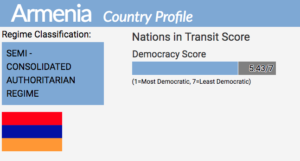 For Armenia, a Russian ally, a member of the Russia-led Eurasian Economic Union (EEU), and once regarded as increasingly autocratic, the 2018 Velvet Revolution was a remarkable achievement, writes Eurasia Democratic Security Network fellow Dr. Karena Avedissian.
For Armenia, a Russian ally, a member of the Russia-led Eurasian Economic Union (EEU), and once regarded as increasingly autocratic, the 2018 Velvet Revolution was a remarkable achievement, writes Eurasia Democratic Security Network fellow Dr. Karena Avedissian.
Despite Armenian Prime Minister Nikol Pashinian’s framing of the protests as an internal issue, many feared Russia would treat the transition as a Western-fomented “colour revolution,” and would lead to direct Russian interference. This however did not happen. How then was Armenia, a three-year member of the EEU, able to pull off a democratic revolution? Avedissian adds:
 Of course, Armenia was unique in the EEU in that it was neither fully autocratic nor fully democratic, in contrast to other member states that are more solidly authoritarian. Armenia’s social media space was exceptionally free for the region; and Armenian civil society was robust and active, with strong networks of young activists. At the same time, Armenia as an EEU member state was being increasingly isolated geopolitically from the West and its democratizing incentives. The EEU ties Armenia even more closely to Russia economically and in terms of security. Armenia cannot pursue its own trade policies with other states without the approval of the other EEU member states. However, none of these factors seemed to present insurmountable obstacles to democratization for Armenia.
Of course, Armenia was unique in the EEU in that it was neither fully autocratic nor fully democratic, in contrast to other member states that are more solidly authoritarian. Armenia’s social media space was exceptionally free for the region; and Armenian civil society was robust and active, with strong networks of young activists. At the same time, Armenia as an EEU member state was being increasingly isolated geopolitically from the West and its democratizing incentives. The EEU ties Armenia even more closely to Russia economically and in terms of security. Armenia cannot pursue its own trade policies with other states without the approval of the other EEU member states. However, none of these factors seemed to present insurmountable obstacles to democratization for Armenia.

Source: Freedom House
“Armenia’s case shows that if the domestic ingredients for a revolution are there, in particular media freedoms and civil society strength, the authoritarian incentive structures within the EEU do not have the capacity to necessarily prevent democratization or related reforms,” Avedissian concludes. RTWT
EDSN is an international research fellowship project of the Center of Social Sciences, Tbilisi, and made possible with the support of the National Endowment for Democracy.







